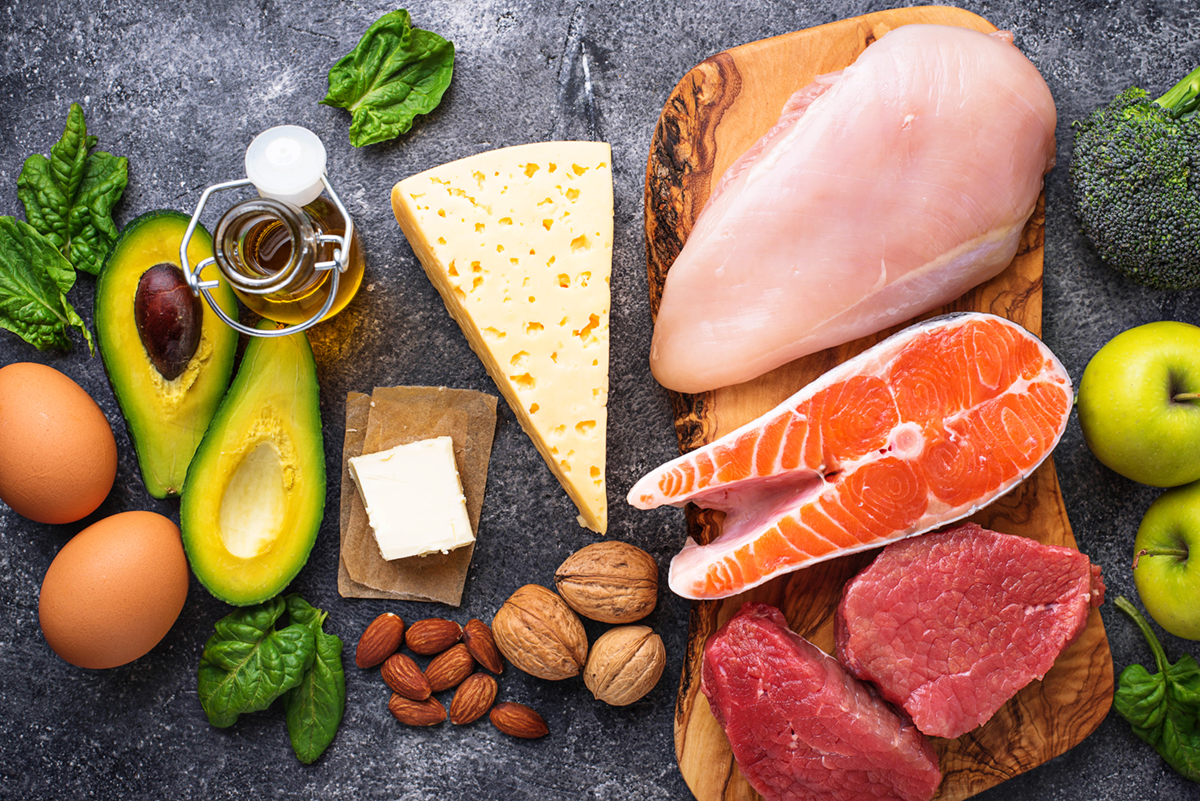The Atkins diet promises not only that a person will lose weight without being hungry, but he or she will also be on the right path to better heart health and memory function, as well as other wellness benefits. The Atkins Diet has been highly successful due to it’s popularity and is considered the iconic low-carb diet.

Beginnings, Dr. Robert Atkins
The Atkins diet was invented by Dr. Robert Atkins (1930-2003) in the 1960's and the first goal of this diet was to resolve his own weight problem. After successfully treating over 10 thousand patients, he popularized the Atkins diet in a series of books called “Dr. Atkins' Diet Revolution”. For several years it was the most famous and most successful diet ever promoted in the US. However, different factors have led to its decreasing in success. The company Atkins Nutritionals of Ronkonkoma, New York, filed for bankruptcy in July 2005. But it still isn't forgotten and the Atkins logo is still visible on different food products and related merchandise.
The Atkins diet principles
The diet is based on the theory that overweight people eat too many carbohydrates. Human bodies burn both fat and carbohydrates for energy, but carbs are used first. By drastically reducing carbs and eating more protein and fat, our bodies should lose weight naturally by burning stored body fat more efficiently.
Atkins claimed there are two main factors in obesity:
- The main cause of obesity is eating refined carbohydrates particularly sugar, flour, and high-fructose corn syrups;
- Saturated fat is overrated as a nutritional problem, and only fats from hydrogenated oils need to be avoided.
Exercise and foods you can eat
The diet plan allows a person to eat foods that many dieters only dream about.
There are some restrictions:
- no refined sugar,
- no milk,
- no white rice,
- no white flour
It generally allows a person to eat foods traditionally regarded as rich: meat, eggs, cheese, and more. The fact is that on the Atkins diet, you're eating almost pure protein and fat. You can consume red meat, fish, fowl, and regular cheese.
Carbs are restricted!
On the other hand, carbs are restricted to about 20 grams of net carbs per day which translates to three cups of loosely packed salad or two cups of salad with two-thirds cup of certain cooked vegetables each day. However, this regimen is kept only in the first week of the diet. Then, over time, the transition from weight loss to weight maintenance is made by gradually increasing carbs so long as gradual weight loss is maintained.
Exercises are important!
Exercise in all phases as part of a healthy lifestyle is now emphasized more than when the diet was first introduced.
Ketosis
Atkins promotes high restriction of the intake of carbohydrates in order to switch the body's metabolism from burning glucose to burning fat. This process is called lipolysis and it normally begins when the body enters the state of ketosis. Ketosis is a state which begins as a consequence of running out of carbohydrates to burn. Ketosis is an entirely normal state but, research has proven that it can cause troubles if prolonged.
Phases of Atkins diet
There are four phases to the Atkins diet.
Induction
The first phase is called Induction. It lasts for at least two weeks, although this phase can be continued for much longer if a person can bear it. During this phase, the person should limit the intake of carbohydrates to a 20g a day. Foods that should be avoided include: biscuits, cakes, chocolate, crisps, fizzy drinks, croissants and pastry, bread, potatoes, pasta, rice, milk, fruit.. The food that’s allowed is red meat, chicken, fish, cheese, eggs, mayo, cream and butter. It’s during the Induction phase that your body switches from burning carbs to burning fat and blood sugar levels stabilize.

Ongoing Weight Loss
The second phase is known as Ongoing Weight Loss. It allows a person to slightly increase carb intake by 5g each day for a week at a time until a person finds Critical Carbohydrate Level for Losing Weight, which is very important. This is the maximum amount of carbohydrates that person can eat each day and still lose between 1 and 3lb a week.
Pre-maintenance
The phase three is called Pre-maintenance. There should be only 5-10lb left to lose. During this phase, the person increases carb intake by 10g each day for a week at a time. The idea is to slow down the weight loss to no more than 1lb a week in an effort to prepare the body for the final phase, weight maintenance.
Lifetime Maintenance
The fourth and final phase, Lifetime Maintenance, aims to help you maintain your weight for longer periods of time. It is a fact that most people need to limit carbs to less than 90g a day.
Atkins diet side effects
Anyone who’s planning to loose some weight should be familiar with the unpleasant side effects which can occur with the Atkins diet. The research has shown that burning fat results in the production of substances called ketones as a body enters a state called ketosis. This can result in:
- bad breath,
- tiredness,
- weakness,
- dizziness,
- insomnia
- nausea
Constipation may also occur as a consequence of avoiding typically high-fibre foods such as fruit, vegetables, beans, whole-wheat pasta, brown rice, wholegrain breakfast cereals and jacket potatoes.
Long term side effects
When it comes to long-term side effects, many experts are concerned that the Atkins diet may cause serious damage. First, the high intake of fat may increase the risk of heart disease. There are also concerns that the unbalanced nature of the Atkins diet may lead to nutritional deficiencies, which cause health problems in later life. For example poor intakes of bone-building calcium may increase the risk of osteoporosis, while poor intakes of antioxidant nutrients have been linked with a host of health problems ranging from heart disease and cancer to premature ageing and cataracts.
Some experts are also worried that high intakes of protein may cause kidney problems or weaken bones.
Success rate
Many people are interested to hear more about success rate but the fact is that precise numbers are difficult to come by. Some recent studies have shown that after a few months of Atkins, people tend to lose about twice as much weight as they would on the standard low-fat, high-carbohydrate approach recommended by most health organizations.
Criticism of the Diet
In several years while the diet was very popular, it has also experienced some serious critics from several different sources. Low-carbohydrate diets have been the subject of heated debate in medical circles for three decades:
Forbes magazine
Forbes magazine found that the Atkins Nutritional Approach is one of the five most expensive diet plans of the ten plans Forbes analyzed. The Atkins diet nevertheless involved more than an 80% premium over average American food expenses.
National Weight Control Registry
This company was tracking the habits of successful dieters over a period of 10 years. Despite this diet's overwhelming popularity compared to other diets, of the 5,000 Americans confirmed to have lost an average of 32 kg who were able to prove they have kept it off for at least 6 years of the decade, less than 1% were confirmed to be Atkins adherents.
Obesity Research magazine
A 2001 scientific review by Obesity Research magazine has determined that initial advantage in weight loss was a result of increased water loss, and that after the initial period, low-carb diets produce similar fat loss to other diets with similar caloric intake.
Physicians Committee for Responsible Medicine
This organization has noted that in East Asian countries, the average person's diet consists mainly of carbohydrates but these countries have very low rates of obesity.
Studies on Atkins diet
Two studies supporting the diet and confirming the weight-loss ability have been publicized. The question is were they reliable enough?
The first study
The first was conducted by the Philadelphia Veterans Affairs Medical Center, where 132 severely obese patients were randomly put on either a low-carbohydrate diet or the low-fat diet. Only 79 people managed to complete the six-month trial. Low-carbohydrate dieters lost an average of 13 pounds, compared to four pounds for low-fat dieters.
The second study
The second study was carried out over one year, led by researchers at the University Of Pennsylvania School Of Medicine. Only 63 obese men and women took part, and were either assigned to a low-fat diet or the Atkins approach. They discovered that at three months, Atkins dieters had lost an average of 14.7 pounds, compared with 5.8 pounds average the low’fat dieters lost; at six months the losses were 15.2 pounds and 6.9 pounds respectively.
There are several reasons why we shouldn’t rely on these studies:
- Both studies were very small.
- Both used obese, or severely obese, participants, which isn't representative of the average dieter.
- There was a high drop-out rate, suggesting that people found the Atkins diet hard to stick to.
- They didn't address the harmful effect the diet could have on the kidneys.
- The difference between the weight losses at the end of the studies wasn't really that big

